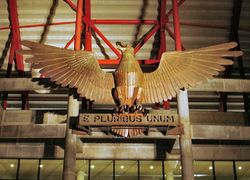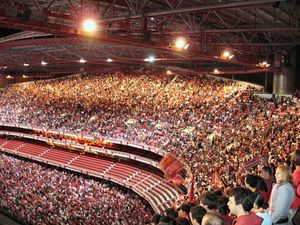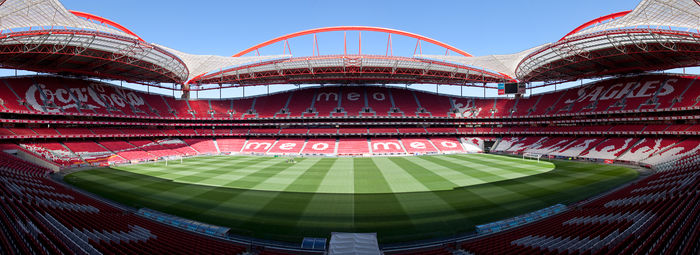Estádio da Luz
| Estádio da Luz | |
|---|---|
.jpg) |
|
| Full name | Estádio do Sport Lisboa e Benfica |
| Location | Lisbon, Portugal |
| Built | 2003 |
| Owner | Sport Lisboa e Benfica |
| Operator | Sport Lisboa e Benfica |
| Surface | Grass |
| Architect | Populous[1] (formerly HOK Sport Venue Event) |
| Capacity | 65,647 |
| Executive Suites | 156 |
| Field dimensions | 105 x 68 m |
| Tenants | |
| Sport Lisboa e Benfica | |

The Estádio da Luz (Portuguese pronunciation: [(ɨ)ˈʃtadiu dɐ ˈluʃ]), officially named the Estádio do Sport Lisboa e Benfica and commonly translated as the Stadium of Light, is a football stadium in Lisbon, Portugal, the home of Sport Lisboa e Benfica. It is also called A Catedral ("The Cathedral") by Benfica's supporters.
The ground is named after "Our Lady of the Light" (Nossa Senhora da Luz, or more commonly, Luz), which is the name of the Lisbon parish where the stadium stands. "Da luz," or "of light," is a common concept in Portuguese Catholic tradition, and basically translates as those "in the presence of God." The people of Lisbon often refer to the original stadium, demolished beginning in 2002, as simply "the light," but the common English name for the stadium became "the stadium of light."
It hosted several matches in the 2004 European Championship, including the final. The previous Benfica stadium (also called Estádio da Luz and one of the largest stadiums in the world with 120,000 seats) was demolished and the new one was built for the tournament with an official capacity of 65,400. Populous designed the stadium to use as much natural light as possible. It is classified by UEFA as an elite-class stadium, allowing it to host major European cup finals. The original Estádio da Luz, opened in 1954, hosted the 1992 European Cup Winners' Cup final before a crowd of well over 120,000, its absolute capacity in those years. Before that final, it also hosted the 1991 FIFA World Youth Championship final held in Portugal with an impressive attendance of 130,000. The original stadium replaced the Estádio do Campo Grande.

Old Estádio da Luz The old Estádio da Luz saw performances from the likes of Eusébio and Rui Costa. It hosted championship after championship during the glory days of the 1950s and 1960s.
In 1999, Portugal was selected as the host of the UEFA Euro 2004 Championship. After many false starts, Benfica presented a proposal for re-building their stadium in order to enable it to become the main venue for that championship.
In October 2003, the stadium opened to a sell out crowd as Benfica took on Nacional Montevideo of Uruguay in an exhibition match.
Contents |
Benfica return
Immediately, Benfica's aspirations seemed revived. In its first season, Benfica went on to conquer the Taça de Portugal (Cup of Portugal). The Encarnados' first trophy in eight years came after beating an impressive Porto side 2–1. FC Porto were, at the time, managed by José Mourinho. Simão was the hero in extra time as Benfica battled back from a goal down to claim the Taça. In the stadium's second season, the team recaptured the title of champions of Portugal after 11 long years. The new stadium was the venue for a historic 1–0 victory over eternal rivals Sporting Clube de Portugal before a 1–1 draw away at Boavista sealed the championship. Following the final whistle, thousands of fans packed into the stadium to celebrate the campeonato (championship).
Architect Damon Lavelle designed the stadium to focus on light and transparency, offering an incentive to name the stadium "Estádio da Luz" (meaning "Stadium of Light" in Portuguese) as the original stadium was named after the neighbourhood the old ground was built on. The polycarbonate roof of the stadium allows the Sun's rays to penetrate it, lighting the stadium. The roof, which is supported by tie beams of four steel arches, seems to float on the underlying tribunes. The arches measure 43 metres in height and help to define the look of the stadium after having been shaped to be similar to the wavy profile of the three tiers of the stadium.
Famous results
2004
- Superliga – Benfica 1–0 Sporting CP
A late goal, attributed to Luisão despite Sporting's goalkeeper apparently fumbling the ball into his own net, handed Benfica a win that ensured they would go into the final match day with their fate in their own hands.
Hosts Portugal came into the match as hot favourites, though it was the minnows Greece who came away with the glory. Angelos Charisteas headed his side in front in the second half and the Greeks held on for a shock win.
2005
- UEFA Champions League – Benfica 2–1 Manchester United. Benfica went into the final match of the UEFA Champions League group stages needing a win against group favourites Manchester United. Benfica had never previously beaten the Reds of Manchester, not even during the days of Eusébio. Benfica's chances of reaching the latter stages of the Champions League for the first time in its modern format seemed limited after Paul Scholes gave Manchester United Football Club a 6th minute lead. But goals from Geovanni and a deflected shot from Beto saw Benfica come back to claim a famous victory.
Superliga – Benfica 4–0 União de Leira. Nuno Gomes scored a hat trick that helped Benfica to their biggest win of the season.
2006
- UEFA Champions League – Benfica 1–0 Liverpool
After being drawn against reigning European Champions Liverpool, no one expected Benfica to pose much threat. Central defender Luisão sprung a surprise when he headed in a winner in the 84th minute to see Benfica win 1–0. Benfica won the return leg 2–0 to claim a famous aggregate victory.
- Superliga – Benfica 1–0 Porto
After ending their 14 year wait for a victory away at Porto, Benfica needed to beat their eternal rivals once again to maintain their challenge for the Championship. Laurent Robert scored his first league goal for Benfica with a long range, bending free kick. Benfica hung on to claim a famous double. In a game to open the season, Benfica beat Bordeaux 2–0 thanks to goals by Fabrizio Miccoli and Marcel.
2010
- Superliga – Benfica 2–1 Rio Ave
Benfica were one point away from their 32nd championship. Thanks to the two goals scored by Óscar Cardozo, Benfica were able to celebrate their 32nd championship, after a five year wait . Cardozo also was able to win the Portuguese Liga Top Scorer after scoring 26 goals, one more goal than FC Porto's Falcao, who scored 25 goals.

References
- ↑ Estádio da Luz architect: Populous
External links
| Preceded by Feijenoord Stadion Rotterdam |
UEFA European Football Championship Final Venue 2004 |
Succeeded by Ernst Happel Stadion Vienna |
|
|||||
|
|||||||||||||||||||||||||||||